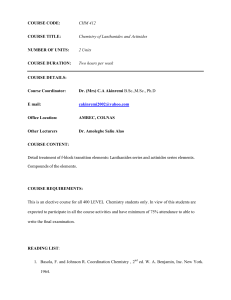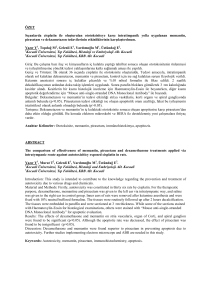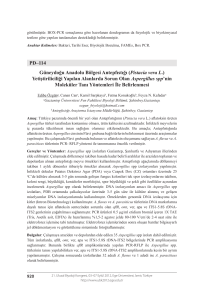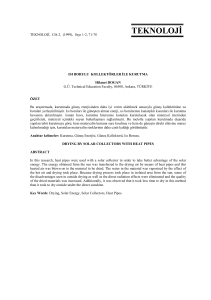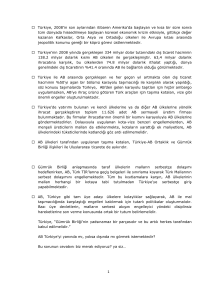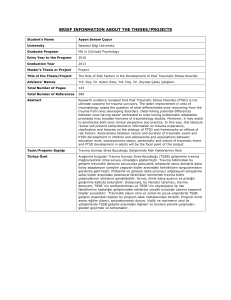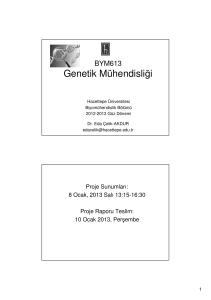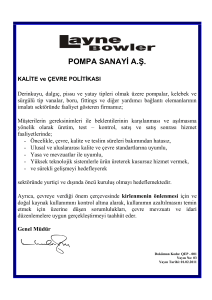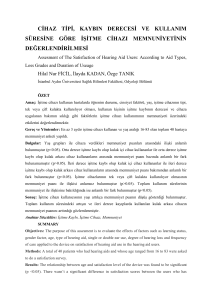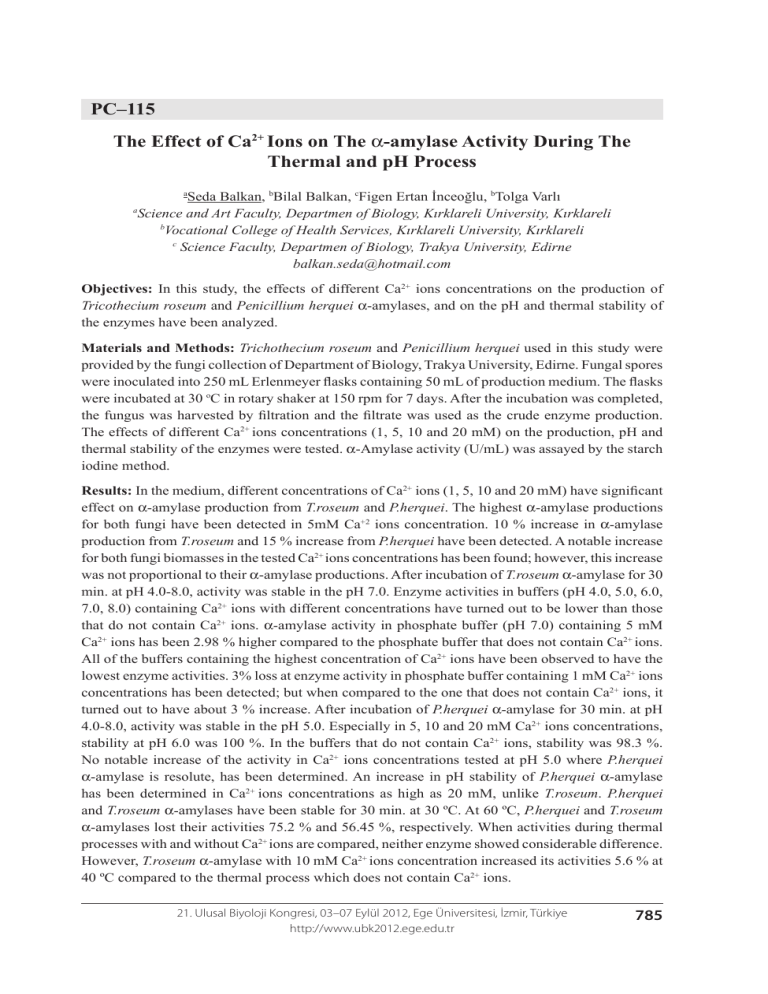
PC–115
The Effect of Ca2+ Ions on The α-amylase Activity During The
Thermal and pH Process
a
Seda Balkan, bBilal Balkan, cFigen Ertan İnceoğlu, bTolga Varlı
Science and Art Faculty, Departmen of Biology, Kırklareli University, Kırklareli
b
Vocational College of Health Services, Kırklareli University, Kırklareli
c
Science Faculty, Departmen of Biology, Trakya University, Edirne
[email protected]
a
Objectives: In this study, the effects of different Ca2+ ions concentrations on the production of
Tricothecium roseum and Penicillium herquei a-amylases, and on the pH and thermal stability of
the enzymes have been analyzed.
Materials and Methods: Trichothecium roseum and Penicillium herquei used in this study were
provided by the fungi collection of Department of Biology, Trakya University, Edirne. Fungal spores
were inoculated into 250 mL Erlenmeyer flasks containing 50 mL of production medium. The flasks
were incubated at 30 oC in rotary shaker at 150 rpm for 7 days. After the incubation was completed,
the fungus was harvested by filtration and the filtrate was used as the crude enzyme production.
The effects of different Ca2+ ions concentrations (1, 5, 10 and 20 mM) on the production, pH and
thermal stability of the enzymes were tested. α-Amylase activity (U/mL) was assayed by the starch
iodine method.
Results: In the medium, different concentrations of Ca2+ ions (1, 5, 10 and 20 mM) have significant
effect on α-amylase production from T.roseum and P.herquei. The highest α-amylase productions
for both fungi have been detected in 5mM Ca+2 ions concentration. 10 % increase in α-amylase
production from T.roseum and 15 % increase from P.herquei have been detected. A notable increase
for both fungi biomasses in the tested Ca2+ ions concentrations has been found; however, this increase
was not proportional to their α-amylase productions. After incubation of T.roseum α-amylase for 30
min. at pH 4.0-8.0, activity was stable in the pH 7.0. Enzyme activities in buffers (pH 4.0, 5.0, 6.0,
7.0, 8.0) containing Ca2+ ions with different concentrations have turned out to be lower than those
that do not contain Ca2+ ions. α-amylase activity in phosphate buffer (pH 7.0) containing 5 mM
Ca2+ ions has been 2.98 % higher compared to the phosphate buffer that does not contain Ca2+ ions.
All of the buffers containing the highest concentration of Ca2+ ions have been observed to have the
lowest enzyme activities. 3% loss at enzyme activity in phosphate buffer containing 1 mM Ca2+ ions
concentrations has been detected; but when compared to the one that does not contain Ca2+ ions, it
turned out to have about 3 % increase. After incubation of P.herquei α-amylase for 30 min. at pH
4.0-8.0, activity was stable in the pH 5.0. Especially in 5, 10 and 20 mM Ca2+ ions concentrations,
stability at pH 6.0 was 100 %. In the buffers that do not contain Ca2+ ions, stability was 98.3 %.
No notable increase of the activity in Ca2+ ions concentrations tested at pH 5.0 where P.herquei
α-amylase is resolute, has been determined. An increase in pH stability of P.herquei α-amylase
has been determined in Ca2+ ions concentrations as high as 20 mM, unlike T.roseum. P.herquei
and T.roseum α-amylases have been stable for 30 min. at 30 ºC. At 60 ºC, P.herquei and T.roseum
α-amylases lost their activities 75.2 % and 56.45 %, respectively. When activities during thermal
processes with and without Ca2+ ions are compared, neither enzyme showed considerable difference.
However, T.roseum α-amylase with 10 mM Ca2+ ions concentration increased its activities 5.6 % at
40 ºC compared to the thermal process which does not contain Ca2+ ions.
21. Ulusal Biyoloji Kongresi, 03–07 Eylül 2012, Ege Üniversitesi, İzmir, Türkiye
http://www.ubk2012.ege.edu.tr
785
Conclusion: Ca2+ions play an important role in amylase production from T.roseum and P. herquei.
This result shows that Ca2+ ions affect both fungi’s metabolism and physiology. Both enzymes in
buffer which do not contain Ca2+ ions are slightly responsive to pH changes. The reason for this
may be that Acetate and Phosphate buffers are not Ca2+ sequestering agents. Although destabilizing
effect of Ca+2 ions added at high concentrations is known, this condition is not valid for P.herquei
α-amylase. During thermal process, Ca2+ ions have not increased the stability of the α-amylases
remarkably. Ca+2 ions did not earn T.roseum and P. herquei α-amylases a significant resistance to
heat. Both denatured α-amylase could not be activated by the added Ca2+ ions.
Key words: α-amylase, Ca2+, Trichothecium roseum, Penicillium herquei.
PC–116
Fenilalanin Amonyum Liyazın Biyoteknolojik Kullanımı İçin Bazı
Bitkilerde Taranması ve Farklı Koşullarda Aktivitesinin Belirlenmesi
Seda ŞİRİN, a,bSelcen Babaoğlu AYDAŞ, aBelma ASLIM
Gazi Üniversitesi, Moleküler Biyoloji Araştırma ve Uygulama Merkezi, Gölbaşı, Ankara
b
Gazi Üniversitesi Sağlık Hizmetleri Meslek Yüksekokulu, Gölbaşı, Ankara
[email protected]
a
a
Amaç: Fenilalanin amonyum liyaz (PAL), son yıllarda fenilketonuri hastalığının tedavisinde enzim
replasmanı için kullanılabilmesi ile öne çıkan alternatif bir enzimdir. Bu çalışmadaki amaç, kültürü
yapılan yenilebilir bazı bitkiler ile doğal yayılış gösteren bazı türlerdeki PAL aktivitesini kıyaslamak
ve yüksek aktiviteye sahip bir bitki enziminin farklı koşullardaki davranışını belirleyerek,
fenilketonüri hastalığına yönelik biyoteknolojik ürün geliştirmede bir potansiyel oluşturabilmektir
Gereçler ve Yöntemler: Çalışmada brokoli (Brassica oleraceae), marul (Lactuca sativa),
maydonoz (Petroselinum crispum), muz (Musa sp.), Barlia robertiana, Centaurea depressa,
Cyclamen alpina, Prangos heyniae bitkileri kullanılmıştır. Enzim ekstraksiyonunun ardından,
fenilalanin amonyum liyaz (PAL) aktivitesi, enzimin fenilalanini parçalayarak oluşturduğu trans
sinnamik asit miktarının 290 nm’de spektrofotometrede ölçülmesi ile belirlenmiş ve µmol/min/
mg protein olarak hesaplanmıştır. Yüksek PAL aktivitesi gösteren C. depressa türüne ait enzimin
aktivitesine farklı çevresel koşulların (pH, sıcaklık, vücut sıvıları gibi) etkisi değerlendirilmiştir.
Ayrıca PAL enziminin farklı substrat derişimleri ile değişen sürelerde reaksiyonu sonucu ortaya
çıkan trans sinnamik asit miktarı HPLC ile de belirlenmiştir.
Bulgular: Yüksek PAL aktivitesi gösteren C. depressa’nın artan pH değerlerinde yükselen bir
enzim aktivitesi gösterdiği belirlenmiştir. Enzimin en iyi aktivite gösterdiği pH 9.5’dir (34.9 ±0.7
µmol/min/mg protein). Enzim bazik pH’da asidik pH’ya göre daha iyi çalışmaktadır. Enzimin
en iyi aktivite gösterdiği sıcaklık 37 oC’dir (34.3±0.7 µmol/min/mg protein). Artan sıcaklıklarda
ise enzim aktivitesi azalmıştır. Yapay mide suyunda enzimin en iyi aktivite gösterdiği pH 4 iken
(19.3±0.6 µmol/min/mg protein), yapay barsak sıvısında pH 8’dir (22.3±2.0 µmol/min/mg protein).
40 mmol/L fenilalanin ile fenilalanin amonyum liyazın 90 dakika reaksiyonu sonucunda oluşan
trans sinnamik asit miktarı 280 nm’de yüksek basınçlı sıvı kromatografisi (HPLC) ile belirlenmiştir.
Trans sinnamik asit miktarı 2.1 mg/L olarak bulunmuştur.
786
21. Ulusal Biyoloji Kongresi, 03–07 Eylül 2012, Ege Üniversitesi, İzmir, Türkiye
http://www.ubk2012.ege.edu.tr

